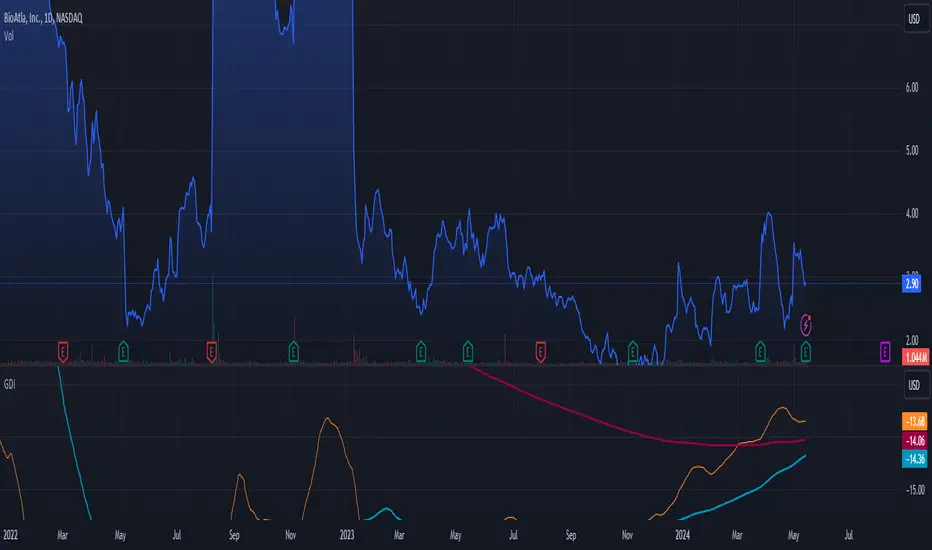PROTECTED SOURCE SCRIPT
Growth/Delcline Index

About:
The Growth/Decline Index is a "parabolic sar" based indicator that mainly has two functions. The first function is to display when price growth or price decline will occur by displaying increases or decreases of the GDI and inflection points. The second function is to rate a stock's performance based on how high or low the digits display the GDI. If the digits read positively, high values then the stock is expected to have growth, and if the digits read negatively, low values then the stock is expected to decline. Remember when looking at the GDI you want to look at both long (yearly) and short(daily) readings to get a better confirmation of trend. The GDI also has short(orange), medium(blue), long(red), readings. The reason why there are three readings is to try to pinpoint buy or selling signals to try to maximize profit. Here is an example of ticker MSFT. As you can see MSFT is reaching long values up to 19! That means that the stock is still in long term growth.

Or how about PEGY having consistent negative values after 2021:

No matter the stock GDI will always be there to help you identify trends, and stock rating.
Want to trade short term? Easy, look at you short values and determine if they are increasing or decreasing.
Be advised:
Please stay in caution when reading the GDI.
Be advised:
The GDI is a new indicator and further behavior analysis such as concave up/down, inflection points, cross over points, divergence/convergence, and minimized/maximized points has to be taken into consideration in order to confirm more precise trends. Also remember that the GDI is a trend tracker and cannot pre identify sudden, large jumps or drops.
-Recommendations/estimates
values for buying: -15 and above
values for short selling -15 and below
What to look for:
Good dips can be found when the medium (blue) line cross from the top downward to the long (red) line and short (orange line) is minimized. (Please keep a look for long term trends)
Or when the short (orange) line has crossed from the top downward to both medium(blue) and long(red) lines.
Remember that this may not be 100% of the case looking for convergence and divergence between the blue and red lines also helps as well as the stock rating and also checking for both long term and short-term readings.
Good peaks can be found when the orange line has greatly exceeded the blue line and has peaked. (also looking at the trend of the blue line helps)
More things can be added and modified to the GDI to make it a cutting-edge indicator.
Have fun. :)
The Growth/Decline Index is a "parabolic sar" based indicator that mainly has two functions. The first function is to display when price growth or price decline will occur by displaying increases or decreases of the GDI and inflection points. The second function is to rate a stock's performance based on how high or low the digits display the GDI. If the digits read positively, high values then the stock is expected to have growth, and if the digits read negatively, low values then the stock is expected to decline. Remember when looking at the GDI you want to look at both long (yearly) and short(daily) readings to get a better confirmation of trend. The GDI also has short(orange), medium(blue), long(red), readings. The reason why there are three readings is to try to pinpoint buy or selling signals to try to maximize profit. Here is an example of ticker MSFT. As you can see MSFT is reaching long values up to 19! That means that the stock is still in long term growth.
Or how about PEGY having consistent negative values after 2021:
No matter the stock GDI will always be there to help you identify trends, and stock rating.
Want to trade short term? Easy, look at you short values and determine if they are increasing or decreasing.
Be advised:
Please stay in caution when reading the GDI.
Be advised:
The GDI is a new indicator and further behavior analysis such as concave up/down, inflection points, cross over points, divergence/convergence, and minimized/maximized points has to be taken into consideration in order to confirm more precise trends. Also remember that the GDI is a trend tracker and cannot pre identify sudden, large jumps or drops.
-Recommendations/estimates
values for buying: -15 and above
values for short selling -15 and below
What to look for:
Good dips can be found when the medium (blue) line cross from the top downward to the long (red) line and short (orange line) is minimized. (Please keep a look for long term trends)
Or when the short (orange) line has crossed from the top downward to both medium(blue) and long(red) lines.
Remember that this may not be 100% of the case looking for convergence and divergence between the blue and red lines also helps as well as the stock rating and also checking for both long term and short-term readings.
Good peaks can be found when the orange line has greatly exceeded the blue line and has peaked. (also looking at the trend of the blue line helps)
More things can be added and modified to the GDI to make it a cutting-edge indicator.
Have fun. :)
受保护脚本
此脚本以闭源形式发布。 但是,您可以自由使用,没有任何限制 — 了解更多信息这里。
免责声明
这些信息和出版物并非旨在提供,也不构成TradingView提供或认可的任何形式的财务、投资、交易或其他类型的建议或推荐。请阅读使用条款了解更多信息。
受保护脚本
此脚本以闭源形式发布。 但是,您可以自由使用,没有任何限制 — 了解更多信息这里。
免责声明
这些信息和出版物并非旨在提供,也不构成TradingView提供或认可的任何形式的财务、投资、交易或其他类型的建议或推荐。请阅读使用条款了解更多信息。